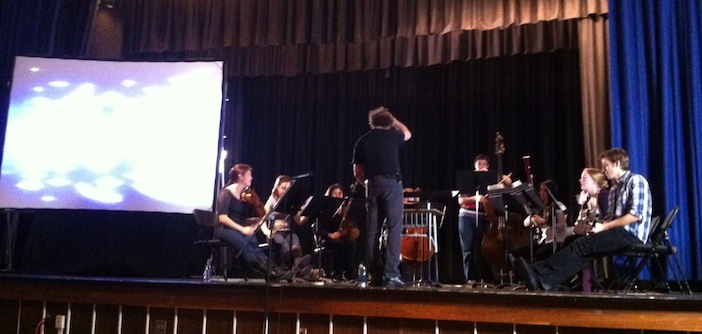
All of Toronto’s music and opera presenters include an educational component in what they do. But the Toronto Symphony Orchestra’s A Toronto Symphony project may be the first time that the city’s children get a hand in actually shaping a mainstage performance.
- Classical Music 101: What Does A Conductor Do? - June 17, 2019
- Classical Music 101 | What Does Period Instrument Mean? - May 6, 2019
- CLASSICAL MUSIC 101 | What Does It Mean To Be In Tune? - April 23, 2019
Last winter, the orchestra announced that Boston-based composer Tod Machover had been commissioned to write A Toronto Symphony, which will get its premiere at this season’s New Creations Festival, on March 9.
The project was designed from the beginning to involve Torontonians, who have over the past months been asked to send in their favourite ambient sounds as well as compositional fragments.
Machover has conceived a seamless, seven-episode piece (you can read the details in a previous post, here). One of these sections will include musical ideas submitted by children from five Toronto District School Board schools, Grades 3 to 8.
Yesterday, all of the children from the participating institutions — Lord Roberts, Pleasant, Gosford, Willowdale and Broadlands Public Schools — gathered in the Brockton-campus auditorium of the College Français to meet the composer and see how Machover will use their work.
The workshop was organized by TDSB instructional leader Janice Lewis, who was as enthusiastic about the project as the 300 or so cheering, applauding children in the auditorium.
The secret to all this enthusiasm is a creation by Machover’s home base, the Media Lab at the Massachusetts Institute of Technology, a composition tool called Hyperscore. This software uses a simple graphical interface to entice even the most inexperienced composer to create organized sound in minutes.
The M.I.T. Media Lab granted bulk licenses to the commercial software to the five schools. When Machover asked for a show of hands for the number of kids who had written a composition using Hyperscore, the room was a waving sea.
Out of all these experiments, Machover had chosen 13 submissions and, of these, had scored five for a chamber-sized ensemble of the Toronto Symphony Youth Orchestra, which performed them live, with Machover conducting.
Hyperscore offers synthesized audio output of its own, but orchestrated by a real composer and played by the excellent young musicians on stage, these miniature compositions from pint-sized composers sounded remarkably sophisticated.
Here is one example, from Broadlands P.S. student Nebyou. What you see on the projection is the Hyperscore screen. The crazy doodle is the composition. The music is being played by members of the Toronto Symphony Youth Orchestra:
A Gosford Grade 4 duo was inspired by a Lawren Harris painting at the AGO to compose a segment they titled “The Art Gallery.” The music sounded as if it could have been written by Jean Françaix.
There were two sets of Grade 3 students who also came up with little pieces that showed a keen sense of rhythm and layering of sound. These are 7-year-olds.
The next step is for Machover to take these fragments and incorporate them into the larger Toronto Symphony.
But the collaborative fun doesn’t end there.
Today, Machover and the TSO are releasing Media Scores, an app that will allow anyone to take a pre-recorded section of the finale from A Toronto Symphony and manipulate it further, then post it in an open forum where visitors can stop by and modify each manipulation again. You can find all the details here.
As someone who is involved with musical outreach to Toronto children, I’m acutely aware every day how difficult it is to translate the highly structured nature of music into an experience that feels not only natural but attractive to kids who operate in a cosmos shaped by stimulus-response.
Hyperscore and similar digital tools (like Torontonian Shaun Elder’s wonderful creations) plug right into that stimulus-response loop. But I have to admit that the ease with which the user becomes a creator worries me, because it feels too easy. Part of me considers this to be a form of pseudo creation, that only the careful application of pencil (and eraser) to notation paper is real creation.
But I have to admit that the kids seriously challenged my mindset yesterday.
Machover had a question-and-answer session with the students after the music ended, and, one after another, the kids asked why they couldn’t do this or that with Hyperscore. They had all gone beyond — or tried to go beyond — the prepackaged aspect of the software, and wanted to know why couldn’t the tempo be changed on the fly? Why couldn’t they change the dynamics of a sustained note?
These children, many of whom I’m sure haven’t had any lessons music theory, were truly and fully engaged with the act of creating music.
Isn’t that what we all dream of?
The fact that their work will eventually find itself performed on the stage of Roy Thomson Hall seems almost superfluous after this amazing accomplishment.
+++
Here’s a little video of Machover working with American children on Hyperscore:
John Terauds
- Classical Music 101: What Does A Conductor Do? - June 17, 2019
- Classical Music 101 | What Does Period Instrument Mean? - May 6, 2019
- CLASSICAL MUSIC 101 | What Does It Mean To Be In Tune? - April 23, 2019



